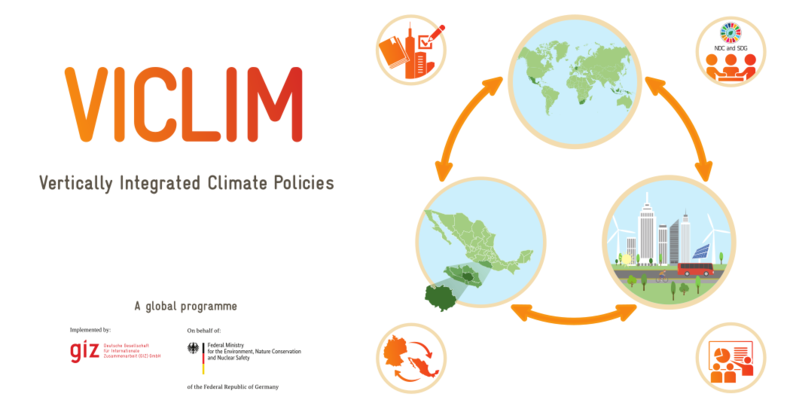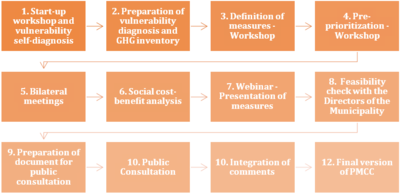Knowledge fuels change - Support energypedia!
For over 10 years, energypedia has been connecting energy experts around the world — helping them share knowledge, learn from each other, and accelerate the global energy transition.
Today, we ask for your support to keep this platform free and accessible to all.
Even a small contribution makes a big difference! If just 10–20% of our 60,000+ monthly visitors donated the equivalent of a cup of coffee — €5 — Energypedia would be fully funded for a whole year.
Is the knowledge you’ve gained through Energypedia this year worth €5 or more?
Your donation keeps the platform running, helps us create new knowledge products, and contributes directly to achieving SDG 7.
Thank you for your support, your donation, big or small, truly matters!
Mainstreaming Climate Change: Puerto Vallarta PMCC
Background
In 2015, the state of Jalisco adopted its Ley para la Acción ante el Cambio Climático (LACC; Law for Action on Climate Change)[1] that requests all municipalities to have a Programa Municipal de Cambio Climático (PMCC; Municipal Climate Change Programme)[2]. Between 2017 and 2018, the Vertically Integrated Climate Policies Programme (VICLIM) supported Jalisco’s Secretariat of Environment and Territorial Development (SEMADET) in preparing guidelines for municipalities for the development of these PMCCs[3]. And in 2019, in cooperation with the Adaptation to climate change in the tourism sector programme (ADAPTUR)[4], VICLIM supported the piloting of the guidelines in the coastal city of Puerto Vallarta so that Puerto Vallarta Municipality could further develop and mainstream its climate policy in order to respond to both adaptation and mitigation challenges imposed by climate change.
Process
The development of the Puerto Vallarta PMCC[5] followed the steps given in the official guidelines. It was a test-run and SEMADET wanted to learn from the use of the guidelines and make amendments if needed. However, the process was also handled in a flexible way and from time to time adapted according to interim results during the process, the degree of access to information and the demands of the actors involved.
In brief, the process looked as follows:
- Start-up: The beginning of the process was made public through a public high level event and workshop with the participation of the Municipal President of Puerto Vallarta and the State of Jalisco´s Secretary of the Environment. In the course of this event, the Municipal President also signed the Municipality’s accession to the Global Covenant of Mayors for Climate and Energy (CoM).
- Diagnosis: The first key activities consisted of several climate related studies to lay the foundation for the planning:
- Institutional and social diagnosis, analysing the social, institutional and capacity dimension installed in the municipality in the matter;
- Diagnosis of vulnerability to climate change;
- GHG Inventory: The calculation of the GHG inventory for 2017 was prepared, taking as a reference the methodology proposed in the Global Protocol for Community-wide Greenhouse Gas Emission Inventories (GPC).
- Definition of measures: Based on the diagnosis, a first list of measures was prepared, which were reviewed and enriched in a wider workshop. With the results, the measures were grouped into five thematic axes.
- Prioritization of measures: Workshops were held to complement, characterize and prioritize the measures, as well as bilateral meetings with the different departments of the municipal administration that will be responsible for implementation of measures. A cost-benefit analysis was carried out to identify the most cost-effective measures that represent the greatest benefits to society. The results were presented through a webinar to the target group to socialize the up-to-date results and collect comments for integration.
- Public consultation: When the first draft of the PMCC was available, a public consultation was carried out, the results[6] were published and the comments were integrated. The public consultation stage consisted of three main measures:
- Public display of document: The draft program was available for consultation during this period at the offices of the Sub-directorate of Environment, Puerto Vallarta Municipality.
- Virtual consultation: The virtual consultation process was open between 1 and 30 September and consisted of an online survey accompanied by information material disseminated on both the channels of the SEMADET and Puerto Vallarta Municipality. In this exercise, more than 300 questionnaires were completed and could be considered for the final version of the program.
- Face-to-face forums: In order to have a more participatory process, three exchange forums were held in the format of working tables where the MCCP was presented and a physical and online survey was requested. These forums were strategically held in three different spaces in order to cover a greater number of the population, including the rural sector and young people:
- The 1st Forum was held on 3 September with a participation of 70 people.
- The 2nd Forum on 4 September was attended by 25 people.
- The 3rd Forum was held on 24 September at the University Center of the Coast, University of Guadalajara, with 113 participants.
- Public display of document: The draft program was available for consultation during this period at the offices of the Sub-directorate of Environment, Puerto Vallarta Municipality.
- Finalisation and official adoption: In January 2020, the municipal council adopted the plan. On 29 April 2020, it was officially published in the Municipality’s Gaceta[7].
Key results and achievements
Mainstreaming
Adaptation and mitigation measures are not an exclusive task of the ‘environmental area’ and ‘environmental department’ of municipal governments. Each area / department and each key local actor must recognise its role and incorporate climate change considerations into its own planning processes, which allows to channel resources and efforts to achieve local development objectives in a climate change context.
Therefore, a key result of the process is that the Municipality incorporated the cross-cutting axis ‘Climate change’ into its overall ‘Development and Governance Plan 2018-2021’ (Plan Municipal de Desarrollo y Gobernanza, PMDyG)[8]. The previous plan (2015-2018) had not explicitly mentioned climate policy[9]. Now, one of Puerto Vallarta’s 29 ‘Development goals’, which include various strategies and lines of action, is to “establish the orderly growth of the municipality with practices focused on sustainability, as well as adaptation and mitigation to climate change in order to improve the quality of life”[10]. This achievement had required coordination among multiple actors, institutions and processes to ensure the internalization of the issue among all: mainstreaming climate change. And this, in turn, is the requirement for a successful implementation of the Municipal Climate Change Programme.
Vertical integration and alignment
On the one hand, the development of the PMCC responds to the legal obligations of Jalisco´s municipalities (according to the State’s LACC) and it used the State’s guidelines for the development of PMCCs that aim at harmonising and better aligning local and state policies. They, for example, regulate the information channels to the Inter-Institutional Commission for Action on Climate Change of the State of Jalisco (Comisión Interinstitucional para la Acción ante el Cambio Climático del estado de Jalisco; CICC) in order to better harmonise policies. For the prioritisation of actions, they refer to and recommend the use the criteria that were also used for the current State’s Climate Change Action Programme (Programa Estatal para la Acción ante el Cambio Climático; PEACC) in order to better align the actions.
On the other hand, the involvement of the State Government, through SEMADET, was fundamental for the state level to be informed on climate policy processes, challenges and opportunities at local level. The programme was also reviewed by the Federal Ministry of Environment and Natural Resources and the process’ takeaways were shared with them in order to provide inputs for future support to the municipal level.
Learning and scaling-up
The involvement of SEMADET also allowed a process of learning. SEMADET will use the experiences to better advise other municipalities and establish better climate governance mechanisms between the State and the municipalities.
In addition, a portal in the form of a blog on experiences and lessons learned during the PMCC development process was created: https://energypedia.info/wiki/Portal:PMCC. To date, it has been accessed more than 10,000 times. It targets primarily the other municipalities around the State of Jalisco and aims at advertising the guidelines and scaling-up the approach.
Success factors
Political ownership
During the development of the PMCC, a constant challenge was to raise the awareness among the various Municipal Directorates, to bring them on board and to have their full support and commitment to implementation. This was being tackled continuously through the leadership by the Environment Deputy Director of Puerto Vallarta, the dedication of his team as well as through the strong support by the Municipal President. In bilateral meetings the vision on the response to climate change and the benefits of implementing the PMCC were shared with the department heads and staff. They were shown how the benefits and co-benefits were in line with the departments’ areas of responsibility and objectives.
Participation
From the start-up workshop onwards, the PMCC coordination team consisting of the Municipality, SEMADET, a consulting team and GIZ staff promoted participatory planning approaches that included representatives of the public sector, academia, civil society and private sector (especially related to tourism) as well as representatives of the neighbouring municipality of Bahía de Banderas. Participatory processes were used to construct a diagnosis of vulnerability to climate change, to present the results of the GHG inventory and the diagnosis of vulnerability with the climate scenarios, identify and prioritize potential climate change adaptation and mitigation measures and to develop and implement the process of citizen consultation.
Data used
The development of measures was based on local studies that feed local policy, as well as on vulnerability diagnosis and GHG inventory. This provides a baseline for subsequent monitoring and evaluation.
Safeguards
During the development and prioritization of the measures, social and environmental safeguards were taken into account with the objective of avoiding negative effects and seeking the benefit of minorities or vulnerable groups.
Transparency
The credibility of a participatory process is intrinsically linked to transparency towards the actors involved. Minutes from each workshop were sent to everyone involved and a broad list of local actors was always invited to participate in the workshops. Prior to the public consultation, a webinar was held in which the results of the first prioritisation analysis and the explanation of the process carried out with the authorities were presented.
References
- ↑ https://www.gob.mx/inecc/documentos/ley-para-la-accion-ante-el-cambio-climatico-del-estado-de-jalisco
- ↑ Third Section Chapter II and Article 7 of the transitory provision
- ↑ Check out the guidelines on SEMADET’s website: https://semadet.jalisco.gob.mx/gobernanza-ambiental/cambio-climatico/guia-para-la-elaboracion-o-actualizacion-de-los-programas
- ↑ Both programmes, VICLIM and ADAPTUR, are part of the International Climate Initiative (IKI), funded by the German Federal Ministry for the Environment, Nature Conservation and Nuclear Safety (BMU): https://www.international-climate-initiative.com.
- ↑ https://www.puertovallarta.gob.mx/2018-2021/gacetas/2018-2021/Gaceta%2012%20WEB.pdf
- ↑ https://www.puertovallarta.gob.mx/2018-2021/img/publicidad/banner/Informe%20Resultados%20Consulta%20PMCC%20PV.pdf
- ↑ "Año 02, Número 12, Extraordinaria" on https://www.puertovallarta.gob.mx/2018-2021/Prensa/gaceta.php
- ↑ PMDyG Puerto Vallarta ’18-’21: https://www.puertovallarta.gob.mx/2018-2021/transparencia/art8/art8/4/a/Plan%20Municipal%20de%20Desarrollo%20y%20Gobernanza%202018-2021.pdf ; page 101
- ↑ INECC (2019): Evaluación Subnacional de la Política Nacional de Cambio Climático. https://www.gob.mx/inecc/prensa/expertos-analizan-experiencias-de-la-evaluacion-subnacional-de-la-politica-nacional-de-cambio-climatico
- ↑ PMDyG Puerto Vallarta ’18-’21, page 104























